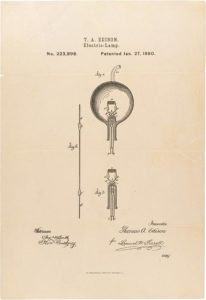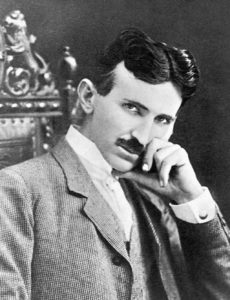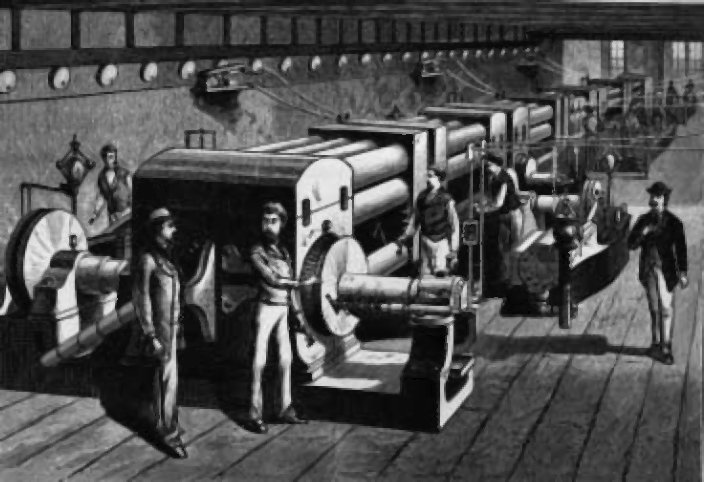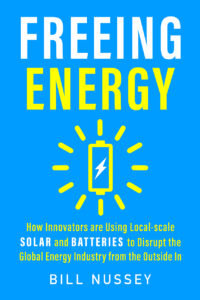
Take a moment to imagine a world without electricity. You will quickly realize how dependent our 21st-century lives are on this invisible and silent form of energy. The modern electric grid was built from the late 1800s through the mid-1900s during one of greatest waves of invention in human history. The century-old power industry is a story of world-changing technology inventions. It is also a story of brilliant, risk-taking visionaries. And not to be overlooked, the power industry is a story of radical new business models that tied the technologies and visionaries together and allowed them to deliver affordable electricity to billions of people across the world.
Over the course of three posts, I’ll break down the history of the U.S. power industry. I’ll cover its strongest partnerships, its bitter rivalries, and the long-term impact that a handful of visionaries would have on the future of civilized life on our planet.
Part 1: Invention

Isaac Newton once said, “If I have seen further it is by standing on the shoulders of giants.” While Thomas Edison might not have said this of himself, his place as the father of modern electricity was built on scientific discoveries and remarkable inventions that began decades before he was born.
In fact, Edison didn’t even invent the electric light bulb. Scientists had spent decades unsuccessfully trying to turn that laboratory curiosity into a commercial product. Edison began his own efforts in 1875 by purchasing the light bulb patents from inventor James Woodward. Five years and 2,000 failed experiments later, it was Edison’s tireless devotion to commercializing scientific curiosities that led to the creation of the first practical, affordable, long-lasting light bulb.
It’s no coincidence the light bulb is now the universal symbol for a bright idea.
Edison’s early proteges ultimately became his largest rivals

As Edison’s empire was building, a young Serbian engineer named Nikola Tesla was finding his own success at the Paris outpost of the Continental Edison Company. Impressed with young Tesla, Edison’s executive team brought him to the U.S. Tesla quit in frustration six months later. This short stint is intriguing because one of history’s greatest business rivalries came tantalizing close to being one of its greatest collaborations.
Around the same time, another young man, British entrepreneur Samuel Insull, came into Edison’s employ as his personal secretary. Insull’s role quickly expanded into overseeing large parts of Edison’s empire and helping him reign in his diverse businesses and patents. After leaving Edison in 1892, Insull went onto play an arguably larger role than Edison in creating the business model for the modern grid, but that nuanced piece of the power puzzle will have to wait until part three of this series.
GET MONTHLY NEWS & ANALYSIS
Unsubscribe anytime. We will never sell your email or spam you.
Edison’s vision and his less-famous invention
Edison’s vision was to replace dirty, dangerous gas lighting systems with the safe and steady illumination of electric light.
We will make electric light so cheap that only the rich will be able to burn candles. — Thomas Edison
An affordable, long-lasting bulb was just the first step. Edison needed a way to power those bulbs that was not only affordable but could be easily available within homes and buildings across the world. Edison decided to create a grid.
And so, he and dozens of his scientists set out to invent, perfect, license or acquire all the necessary components of the world’s first grid. They assembled light sockets, switches, safe wiring, electric meters, and every other component into a single, integrated system. One of Edison’s greatest inventions and one that he gets relatively little credit for was the business model that made all this work. He realized that the only way to make power cheap enough was to create electricity in high volumes by implementing large-scale, centralized generators whose costs could be shared across hundreds of customers. On September 4, 1882, at 3 p.m., Edison turned on the generators at Pearl Street Station in Lower Manhattan and America’s first electric grid was born.

Throughout his career, Edison thought of electricity in much the same way scientists had viewed it for centuries – a continuous flow of electric current in a single direction. This is called direct current or DC. Early batteries generated DC. Early motors ran on DC. It was an obvious choice. The only hitch was that there was no way to change DC voltage after it was generated. If the voltage was too low, more current would be required to make up for it. Higher currents would heat up wires and cause power to be lost even over a few hundred feet. On the other end, if the voltage was too high, it became dangerous to run through the walls of houses. So, Edison designed his systems for a middle-of-the-road output of 110 volts. His choice proved to be farsighted: 110 volts continues to be the voltage used in the U.S. and throughout much of the world today.
Money and business models powered Edison’s empire
The late 1800’s gave rise to legendary business figures like John D. Rockefeller, JP Morgan, and Cornelius Vanderbilt. It was the money and resolve of these business titans that helped fund and create the infrastructure that defined American progress in the 1900’s.

Edison’s first power plant was powered by coal. But it was also powered by money from banking wizard, John Pierpont Morgan (history refers to him as JP Morgan). Morgan first invested in Edison in 1878. He became Edison’s first residential customer and the first homeowner in the world with electric power in 1882. Morgan’s electric lights required their own coal generator (or dynamo as it was called then). Despite the noise and the smell of this miniature power plant, Morgan’s home became a showcase for electric lighting. Within months, the rest of the world wanted it. What would one day become the largest industry on earth had just been born.
Still, inventing a practical light bulb, creating a working grid, and securing hefty financing were not enough. Very few people had the money for a system like Morgan’s. Edison needed to make electric lighting affordable to everyone and turn it into a long-term profitable business. He needed to create a new business model that had never existed before.
It could be argued that centralized power production is the first breakthrough business model in the electricity industry. Edison realized that while making generators bigger made them more expensive, the number of people they could serve grew faster than the costs to build and operate them. Thus, the law of volume manufacturing kicked in – prices go down faster than volumes go up. Like many business model innovations, new approaches create an entirely new set of challenges. For example, Edison had no way to measure the amount of electricity used by each of his customers. To solve this, he found a technology to license, perfected it in his labs, and created the world’s first electric meter.

History often sees Edison’s light bulb as evidence of his genius. For me, his genius was his ability to pull together technology and business models as varied as standard-sized sockets and electric meters into a single system. It wasn’t that he made a light bulb. His genius was that he made electric lighting affordable for the world.
Over the next decade, Edison and Morgan grew their company and restructured Edison’s sprawling holdings into one organization which became the Edison General Electric company. Today, that company is known as General Electric, one of the oldest, largest, and most iconic companies in business history.
The sparks that started the AC/DC current wars
Like Coke and Pepsi and like Microsoft and Apple, few giant markets are ever left uncontested. Edison and Morgan’s meteoric rise would quickly find daunting competition from a surprising visionary and a new technology called Alternating Current that few had taken seriously.
The second part of this story can be read here: AC vs DC: How better economics ultimately beat out a bizarre publicity campaign.
Sources:
- History of Electricity: http://instituteforenergyresearch.org/history-electricity/#Dawn
- The History of Electricity – A Timeline: http://www.thehistoricalarchive.com/happenings/57/the-history-of-electricity-a-timeline/
- AC/DC: The Tesla-Edison Feud: http://mentalfloss.com/article/30140/acdc-tesla%E2%80%93edison-feud
- Edison vs. Westinghouse: A Shocking Rivalry: https://www.smithsonianmag.com/history/edison-vs-westinghouse-a-shocking-rivalry-102146036/
- Samuel Insull: Who Made America?: http://www.pbs.org/wgbh/theymadeamerica/whomade/insull_hi.html
- Before There Was Enron, There Was Insull: http://www.nytimes.com/2006/03/19/business/yourmoney/before-there-was-enron-there-was-insull.html
- A Brief History of the Light Bulb: https://www.popularmechanics.com/technology/gadgets/g1096/a-brief-history-of-the-lightbulb/
- The Incandescent Lamp: https://www.youtube.com/watch?time_continue=74&v=aPaeIFjpoQ8
- Thomas Edison: https://en.wikipedia.org/wiki/Thomas_Edison
- Nikola Tesla: https://en.wikipedia.org/wiki/Nikola_Tesla



